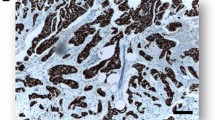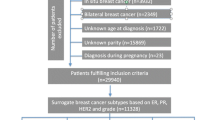Abstract
Purpose
Some reproductive factors are well-known general risk factors for breast cancer (BC). On the other hand, BC subtypes also have a high prognostic value. Correlations, however, that link these risk factors to the development of a particular one of the different BC subtypes are still poorly understood. The primary objective of our study was to assess the influence of different reproductive factors (duration of breastfeeding, parity, and age at first childbirth) on pathological BC subtypes. Secondarily, we correlated body mass index (BMI), age at primary diagnosis, and smoking behavior with tumor subclasses.
Patients and methods
We performed a retrospective chart review of 1082 patients with BC who had been treated for postmenopausal BC at the Heidelberg University Hospital during the period 2009–2014. For statistical analysis, different types of correlation analysis as well as a logistic regression model were used.
Results
Relating to the primary objective, we found that patients with luminal-like BC had significantly fewer children than patients with triple-negative or HER2-positive subtype tumors (P = 0.027). Concerning the duration of breastfeeding, patients with a luminal A-like tumor had a significantly lower mean nursing period than patients with other subtypes (P = 0.012). Furthermore, patients who did breastfeed presented with a significantly lower number of hormone receptor-positive tumors (estrogen receptor-positive, P = 0.04; progesterone receptor-positive, P = 0.017) but the highest rate of HER2-overexpressing malignancies (P = 0.011). Moreover, late first childbirth was associated with the occurrence of luminal tumors (OR 0.952; P = 0.041). Regarding our secondary aim, higher BMI (P = 0.031) and higher age at primary diagnosis (P = 0.038) were both found to be significantly associated with luminal-like BC.
Conclusion
The results suggest a correlation of the occurrence of luminal-like BC subtypes with low parity and short or no duration of breastfeeding. Prospective investigations are needed for further confirmation and to evaluate the molecular basis of our findings.


Similar content being viewed by others
References
RobertKochInstitut (2015) Breast Cancer. http://www.krebsdaten.de/Krebs/EN/Content/Cancer_sites/Breast_cancer/breast_cancer_node.html. Accessed May 5, 2015
Perou CM, Sorlie T, Eisen MB et al (2000) Molecular portraits of human breast tumours. Nature 406:747–752
Goldhirsch A, Wood WC, Coates AS, Gelber RD, Thurlimann B, Senn HJ (2011) Strategies for subtypes–dealing with the diversity of breast cancer: highlights of the St. Gallen International Expert Consensus on the Primary Therapy of Early Breast Cancer 2011. Ann Oncol 22:1736–1747
Blows FM, Driver KE, Schmidt MK et al (2010) Subtyping of breast cancer by immunohistochemistry to investigate a relationship between subtype and short and long term survival: a collaborative analysis of data for 10,159 cases from 12 studies. PLoS Med 7:e1000279
Collaborative Group on Hormonal Factors in Breast Cancer (2002) Breast cancer and breastfeeding: collaborative reanalysis of individual data from 47 epidemiological studies in 30 countries, including 50,302 women with breast cancer and 96,973 women without the disease. Lancet 360:187–195
Kelsey JL, Gammon MD, John EM (1993) Reproductive factors and breast cancer. Epidemiol Rev 15:36–47
Goldhirsch A, Winer EP, Coates AS et al (2013) Personalizing the treatment of women with early breast cancer: highlights of the St Gallen International Expert Consensus on the Primary Therapy of Early Breast Cancer 2013. Ann Oncol 24:2206–2223
Team RC (2013) R: A language and environment for statistical computing. http://www.R-project.org/
Institut RK. Krebs in Deutschland 2009/2010. Robert Koch-Institut und die Gesellschaft der epidemiologischen Krebsregister in Deutschland e.V. 2013
Pötzsch O (2012) Geburten in Deutschland. In: Statistisches Bundesamt W (ed)
Lange C, Schenk L, Bergmann R (2007) [Distribution, duration and temporal trend of breastfeeding in Germany. Results of the German Health Interview and Examination Survey for Children and Adolescents (KiGGS)]. Bundesgesundheitsblatt Gesundheitsforschung Gesundheitsschutz 50:624–633
Horn J, Opdahl S, Engstrom MJ et al (2014) Reproductive history and the risk of molecular breast cancer subtypes in a prospective study of Norwegian women. Cancer Causes Control 25:881–889
Yang XR, Chang-Claude J, Goode EL et al (2011) Associations of breast cancer risk factors with tumor subtypes: a pooled analysis from the Breast Cancer Association Consortium studies. J Natl Cancer Inst 103:250–263
Yang XR, Sherman ME, Rimm DL et al (2007) Differences in risk factors for breast cancer molecular subtypes in a population-based study. Cancer Epidemiol Biomarkers Prev 16:439–443
Tamimi RM, Colditz GA, Hazra A et al (2012) Traditional breast cancer risk factors in relation to molecular subtypes of breast cancer. Breast Cancer Res Treat 131:159–167
Millikan RC, Newman B, Tse CK et al (2008) Epidemiology of basal-like breast cancer. Breast Cancer Res Treat 109:123–139
Gaudet MM, Press MF, Haile RW et al (2011) Risk factors by molecular subtypes of breast cancer across a population-based study of women 56 years or younger. Breast Cancer Res Treat 130:587–597
Kumar P, Aggarwal R (2016) An overview of triple-negative breast cancer. Arch Gynecol Obstet 293:247–269
Phipps AI, Malone KE, Porter PL, Daling JR, Li CI (2008) Reproductive and hormonal risk factors for postmenopausal luminal, HER-2-overexpressing, and triple-negative breast cancer. Cancer 113:1521–1526
Cleland WH, Mendelson CR, Simpson ER (1985) Effects of aging and obesity on aromatase activity of human adipose cells. J Clin Endocrinol Metabol 60:174–177
Author information
Authors and Affiliations
Corresponding author
Ethics declarations
Conflict of interest
No actual or potential conflicts of interest were disclosed.
Grant support
None.
Ethical approval
All procedures performed in studies involving human participants were in accordance with the ethical standards of the institutional and/or national research committee and with the 1964 Helsinki declaration and its later amendments or comparable ethical standards.
Informed consent
Informed consent was obtained from all individual participants included in the study.
Rights and permissions
About this article
Cite this article
von Au, A., Klotzbuecher, M., Uhlmann, L. et al. Impact of reproductive factors on breast cancer subtypes in postmenopausal women: a retrospective single-center study. Arch Gynecol Obstet 295, 971–978 (2017). https://doi.org/10.1007/s00404-017-4298-8
Received:
Accepted:
Published:
Issue Date:
DOI: https://doi.org/10.1007/s00404-017-4298-8




